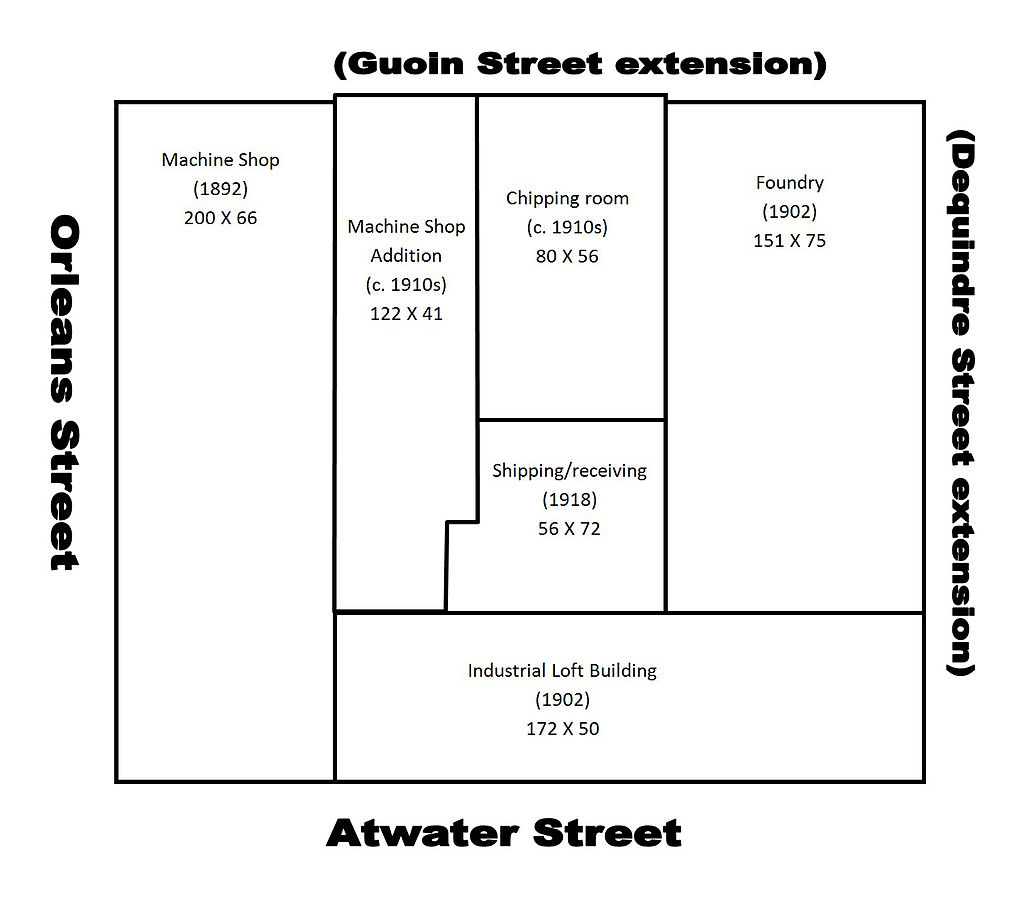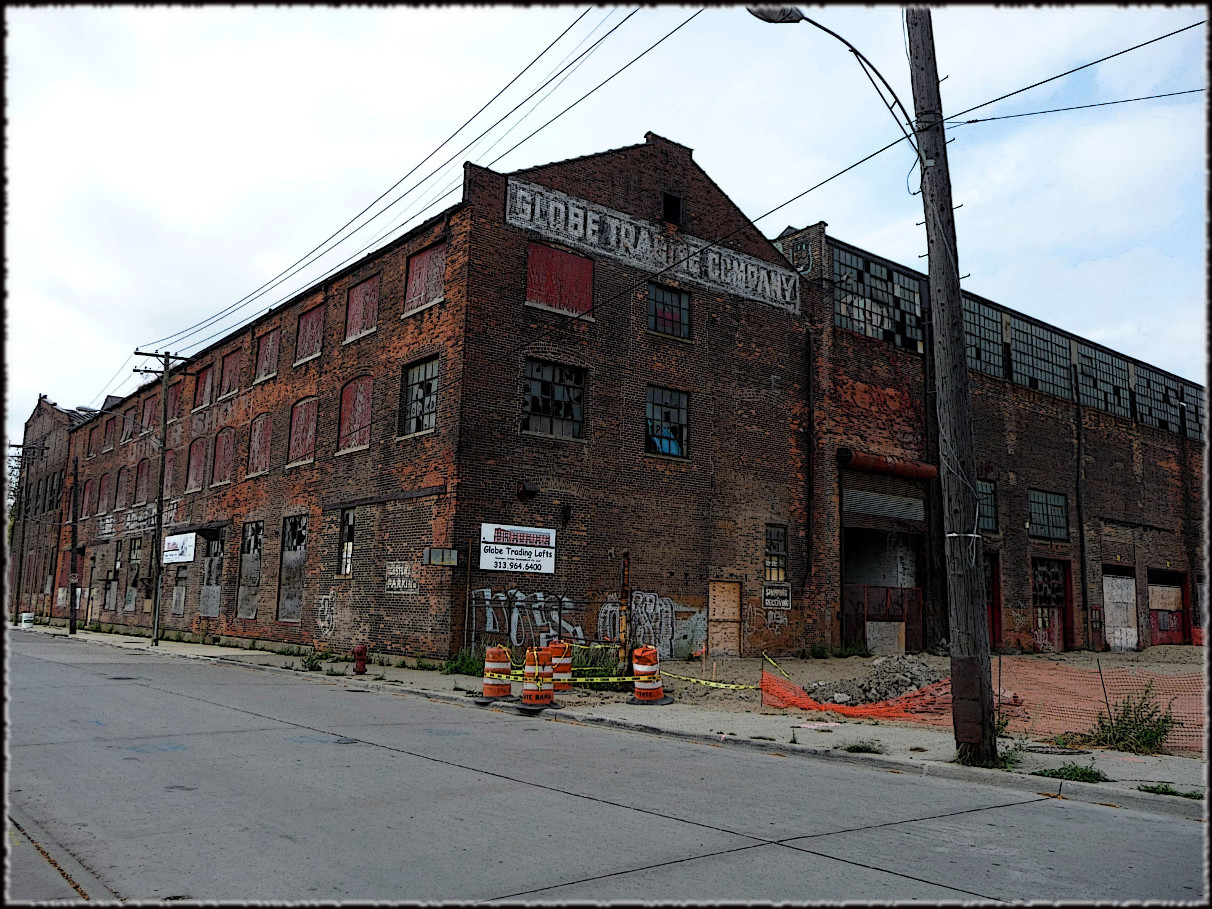Dry Dock Complex of Detroit
- Detroit ~D~ Palinopsia
Contents
Introduction
The Dry Dock Complex consists of six interconnected buildings located at 1801–1803 Atwater Street in Detroit, Michigan, as well as the remains of a nearby dry dock at 1900 Atwater Street. The 1801-1803 Atwater complex is also known as the Globe Trading Company Building. The complex is significant as a historic maritime manufacturing facility. The earliest structure, an 1892 machine shop, is also significant as an early example of an industrial building entirely supported by its steel frame, but using traditional brick and standard windows to infill the curtain walls. The complex was listed on the National Register of Historic Places in 2009. In 2012, the Department of Natural Resources received funding for historic redevelopment of the complex, along the city's east riverfront promenade.
History
The Dry Dock Engine Works-Detroit Dry Dock Company Complex includes pieces of two once-independent companies—the Dry Dock Engine Works and the Detroit Dry Dock Company—which merged in 1899.
Detroit Dry Dock Company
In the 1840s, Captain Stephen R. Kirby began a shipbuilding firm in Cleveland, Ohio, and by 1852 had moved to Saginaw, Michigan. In 1870, Kirby's son Frank, a Cooper Union-trained engineer, joined the firm as lead designer. (Frank Kirby went on to a successful shipbuilding career, which included the design of two National Historic Landmarks: the Columbia and the Ste. Claire.) In 1872, the Kirby's firm purchased a shipyard in Wyandotte, Michigan.
In 1852, Campbell, Wolverton and Company opened a ship repair yard on the Detroit River at the foot of Orleans Street. In 1860 the firm, now known (with the addition of John Owen as president) as Campbell & Owen, constructed a 260' dry dock in the same location. They constructed their first steamship in 1867.
In 1877, Campbell & Owen reorganized, changing its name to the Detroit Dry Dock Company. At about the same time, Detroit Dry Dock purchased the Kirby's Wyandotte shipbuilding firm. Also in the late 1870s, railroad and shipping magnate James McMillan became interested in shipbuilding, purchasing shares in Detroit Dry Dock. By 1890, McMillan was president of the company, and by 1892 was also president of the nearby Dry Dock Engine Works.
Dry Dock Engine Works
Dry Dock Engine Works, a marine engine manufacturer, was formed in 1866 by William Cowie, Edward Jones, and Robert Donaldson, with Cowie as president. The firm set up shop on Atwater, between Orleans and Dequindre, across from the dry dock firm that was then called Campbell & Owen. The firm slowly acquired surrounding lots, and by 1880 owned nearly the entire city block back to Guoin Street. (The city vacated Dequindre in the vicinity of the Dry Dock Engine Works in 1917, and Guoin some time later; neither street currently exists in the area.)
The main product line of the Dry Dock Engine Works was marine engines, and they produced 129 engines between 1867 and 1894. However, the firm also produced stationary and portable steam engines, as well as mining equipment, mill gearing, and brass and iron casting. In 1883, Dry Dock Engine Works bought the nearby boiler shop of Desotell & Hudson, expanding their product line.
Although unimportant at the time, the Dry Dock Engine Works is significant as an early employer of Henry Ford. The future automobile magnate worked at the firm between 1880 and 1882 as an apprentice machinist. His work with steam engines at the Dry Dock Engine Works inspired in part Ford's later idea of adding an engine to a carriage for road use.
The Dry Dock Engine Works had always had a special relationship with the nearby Detroit Dry Dock Company, which only increased as the years passed. In the 1870s, Dry Dock Engine Works sold over 1/3 of their engines to Detroit Dry Dock; by the early 1890s that fraction had increased to nearly 2/3. The ties were enhanced by the fact that Frank Kirby, John Owen, and James McMillan of Detroit Dry Dock slowly acquired shares in Dry Dock Engine Works. By the end of the 1880s, virtually all of the Dry Dock Engine Works shares were owned by Detroit Dry Dock principals. In 1892, James McMillan took over the presidency of Dry Dock Engine Works, and the two firms were controlled by the same person. It was around this time that the oldest of the remaining structures in the complex, the machine shop and dry dock no. 2, were built.
Integration: Detroit Shipbuilding Company
Although even after 1892 the two firms were technically separate, they essentially operated as a single business unit, with the same principals in charge of both. In 1899, this relationship became more formal, as the Dry Dock Engine Works, the Detroit Dry Dock Company, and the Detroit Sheet Metal and Brass Works were combined to form the Detroit Shipbuilding Company, which itself was a subsidiary of the American Shipbuilding Company headquartered in Cleveland, Ohio. The integration of these operating units created a substantial company: in 1900, the Detroit Shipbuilding Company employed 1337 people, and was the fourth-largest employer in Detroit.
A few years later, in 1902, the Detroit Shipbuilding Company built two more still-surviving structures, the foundry and the industrial loft building. Sometime in the 1910s, three more structures were built, which completed the enclosure of the block where the original Dry Dock Engine Company was founded, and represent the latest of the surviving buildings of the complex.
Shipbuilding continued at the facilities in Wyandotte and Detroit through the 1920s, with a substantial number of ships constructed in the World War I years of 1917-1919. However, business soon decreased and in 1920 the yard in Wyandotte was closed as a cost-cutting measure.[15] Not long afterward, in 1924, a pair of steamers were fitted up in the Detroit yards; these two proved to be the last vessels constructed in Detroit by the American Shipbuilding Company.[16] The Detroit Shipbuilding Company completely ceased operations in 1929.
Post-maritime Usage

The property owned by the Detroit Shipbuilding Company at Atwood and Orleans passed through several hands, being used by a cabinet shop and a stove manufacturer in the early 1930s. In 1935, the property was acquired by the Detroit Edison Company. is unclear what use, if any, Detroit Edison put the property to in the 1930s and 40s, but in the 1950s and 60s Edison used the engine-building plant as a reconditioning and appliance shop. By 1968, the property was occupied by the Globe Trading Company, a machinery and mill supplies dealer. In 1981, Edison sold the property to Globe. At some time later, the property was abandoned, and by 2002 was empty and owned by the city of Detroit.
Sources
https://en.wikipedia.org/wiki/Dry_Dock_Complex_(Detroit,_Michigan)
